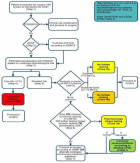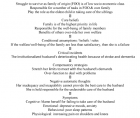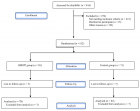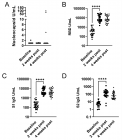Abstract
Research Article
Which women uses social Internet networks during pregnancy?
Sylvie Viaux-Savelon*, Catherine Fouillet, Nicolas Bodeau and Jacky Nizard
Published: 31 March, 2021 | Volume 4 - Issue 1 | Pages: 025-032
Internet has become an important part of our life, including during pregnancy where it is broadly used to find information (84%). The aims of this study were (1) to describe the proportion of women using Internet Social Networks (ISN) concerning their pregnancy, during pre or postpartum hospital stay, (2) to define how ISN users refer to their pregnancy and delivery on these social networks, (3) to compare anxiety level, social sustain level, sociodemographic characteristics of the both population (4) and to determine profiles of the ISN users with multiple correspondence analysis.
Methods: 399 questionnaires were distributed in the postpartum wards of two academic hospitals in Paris, and 258 fully filled were retrieved. Tools: Anxiety scale (STAI- A and B), Cutrona Social Provisions Scale, sociodemographic and obstetrical questionnaire.
Results: 76% (n = 195) were ISN users. We compared ISN users versus ISN non users women. Demographically, the two populations were comparable. Anxiety scores were similar in both groups, whereas social support scores showed a statistical difference in social integration.
In the global population, 84% use Internet for information concerning pregnancy; this rate is higher for ISN users than ISN non users (tendency 0.058).
ISN were used in priority for sharing with relatives, and 10% with other pregnant women. Concerning pregnancy, patients posted in priority the birth announcement (28%), the pregnancy announcement (23%), and the newborn’s pictures (12%). 6% posted their fetuses’ ultrasound pictures.
Three clusters of ISN users were extracted with statistically different social support scores (p = 0.019) and comparable anxiety scores. The third one, with at risk profile, used ISN as social support. For all women, but specifically for younger and more socially fragile women, Internet gives to professional new perspectives to develop information and prevention tools during the perinatal period.
Read Full Article HTML DOI: 10.29328/journal.cjog.1001082 Cite this Article Read Full Article PDF
Keywords:
Internet social network; Pregnancy social support; Anxiety; Prevention
References
- Coeffe T. L'usage d'Internet, du mobile et des réseaux sociaux dans 232 pays (dont la France). 2016.
- Yee W. We are social. 2016. www.fr.slideshare.net/wearesocial.sg/digital-in-2016.
- Sayakhot P, Carolan-Olah M. Internet use by pregnant women seeking pregnancy-related information: a systematic review. BMC Pregnancy Childbirth. 2016; 28; 16: 65. PubMed: https://pubmed.ncbi.nlm.nih.gov/27021727/
- Prescott J, Mackie L. "You Sort of Go Down a Rabbit Hole...You're Just Going to Keep on Searching": A Qualitative Study of Searching Online for Pregnancy-Related Information During Pregnancy. J Med Internet Res. 2017; 19: e194. PubMed: https://pubmed.ncbi.nlm.nih.gov/28583906/
- Lagan BM, Sinclair M, Kernohan WG. Internet use in pregnancy informs women's decision making: a web-based survey. Birth. 2010; 37: 106-115. PubMed: https://pubmed.ncbi.nlm.nih.gov/20557533/
- Lagan BM, Sinclair M, Kernohan WG. What is the impact of the Internet on decision-making in pregnancy? A global study. Birth. 2011; 38: 336-345. PubMed: https://pubmed.ncbi.nlm.nih.gov/22112334/
- Konheim-Kalkstein YL, Whyte R, Miron-Shatz T, Stellmack MA. What are VBAC Women Seeking and Sharing? A Content Analysis of Online Discussion Boards. Birth. 2015; 42: 277-282. PubMed: https://pubmed.ncbi.nlm.nih.gov/26032668/
- O'Higgins A, Murphy OC, Egan A, Mullaney L, Sheehan S, et al. The use of digital media by women using the maternity services in a developed country. Ir Med J. 2014; 107: 313-315. PubMed: https://pubmed.ncbi.nlm.nih.gov/25556255/
- Lupton D. The use and value of digital media for information about pregnancy and early motherhood: a focus group study. BMC Pregnancy Childbirth. 2016; 16: 171. PubMed: https://pubmed.ncbi.nlm.nih.gov/27435182/
- Gauthier J, Bouchard S. A French-Canadian adaptation of the revised version of Spielberger's State-Trait Anxiety Inventory. Canadian J Behav Sci. 1993.
- Julian L. Measures of Anxiety. State-Trait Anxiety Inventory (STAI), Beck Anxiety Inventory (BAI), and Hospital Anxiety and Depression Scale-Anxiety (HADS-A). Arthritis Care Res. 2011; 63: S467-S472. PubMed: https://pubmed.ncbi.nlm.nih.gov/22588767/
- Spielberger C. State-Trait Anxiety Inventory. Consulting Psychologists Press, Palo Alto (CA). 1983.
- Caron J, Tremblay M. The scale of social provisions: their validation in Quebec. 1996; 21: 158-180. PubMed: https://pubmed.ncbi.nlm.nih.gov/9052268/
- Russell D, Peplau LA, Cutrona CE. The revised UCLA Loneliness Scale: concurrent and discriminant validity evidence J Pers Soc Psychol. 1980; 39: 472-480. PubMed: https://pubmed.ncbi.nlm.nih.gov/7431205/
- Leune AS, Nizard J. Doctor Google: Use of Internet during pregnancy in France in 2009.. 2012; 41: 243-254. PubMed: https://pubmed.ncbi.nlm.nih.gov/22236487/
- Koufopoulos JT, Conner MT, Gardner PH, Kellar I. A Web-Based and Mobile Health Social Support Intervention to Promote Adherence to Inhaled Asthma Medications: Randomized Controlled Trial J Med Internet Res. 2016; 18: e122. PubMed: https://pubmed.ncbi.nlm.nih.gov/27298211/
- Tapper K, Jiga-Boy G, Maio GR, Haddock G, Lewis M. Development and preliminary evaluation of an internet-based healthy eating program: randomized controlled trial. J Med Internet Res.2 014; 16: e231. PubMed: https://pubmed.ncbi.nlm.nih.gov/25305376/
- Zimmer B, Moessner M, Wolf M, Minarik C, Kindermann S, et al. Effectiveness of an Internet-based preparation for psychosomatic treatment: Results of a controlled observational study. J Psychosom Res. 2015; 79: 399-403. PubMed: https://pubmed.ncbi.nlm.nih.gov/26526315/
- Knight M, Tuffnell D, Kenyon S, Shakespeare J, Gray R, et al. Saving Lives, Improving Mothers’ Care - Surveillance of maternal deaths in the UK 2011-13 and lessons learned to inform maternity care from the UK and Ireland Confidential Enquiries into Maternal Deaths and Morbidity 2009-13. National Perinatal Epidemiology Unit, University of Oxford, Oxford. 2015.
- Tubach F, Greacen T, Saias T, Dugravier R, Guedeney N, et al. A home-visiting intervention targeting determinants of infant mental health: the study protocol for the CAPEDP randomized controlled trial in France. BMC Public Health. 2012; 12: 648. PubMed: https://pubmed.ncbi.nlm.nih.gov/22888979/
- Riviere C. Le lien de dépendance addictive à Internet, une nouvelle forme d'addiction? OMNSH. 2006; 10: 66.
- Tisseron S. Doctors and the benefits and dangers of social networks. Rev Med Suisse. 2015; 11: 1082-1084. PubMed: https://pubmed.ncbi.nlm.nih.gov/26118232/
- Bion WR. Aux sources de l'expérience. PUF, PARIS. 2003.
- Bernard-Chatelain C. L'e-baby, l'e-mother et le forum de maman blues. Spirale 4. 2011.
- Now R. Naissance numérique: bienvenue dans le monde d'internet. Selon une étude d'AVG, un quart des enfants sont présents sur internet bien avant leur naissance. 2010.
- Viaux-Savelon S. La parentalité échographique. Dialogue. 2013; 1: 19-31.
- Gelaye B, Kajeepeta S, Williams MA. Suicidal ideation in pregnancy: an epidemiologic review. Arch Womens Ment Health. 2016; 19: 741-751. PubMed: https://pubmed.ncbi.nlm.nih.gov/27324912/
- Mehdizadeh S. Self-presentation 2.0: narcissism and self-esteem on Facebook Cyberpsychol Behav Soc Netw. 2010; 13: 357-364. PubMed: https://pubmed.ncbi.nlm.nih.gov/20712493/
- Prizant-Passal S, Shechner T, Aderka IM. Social anxiety and internet use-A meta-analysis: What do we know? What are we missing? Computers in Human Behavior. 2016; 62: 221-229.
- Tebeka S, Le Strat Y, Dubertret C. Developmental trajectories of pregnant and postpartum depression in an epidemiologic survey. J Affect Disord. 2016; 203: 62-68. PubMed: https://pubmed.ncbi.nlm.nih.gov/27280964/
Figures:
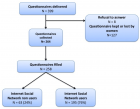
Figure 1

Figure 2
Similar Articles
-
Effectiveness of the lifestyle modifications in prevention and control of sexually transmitted diseases (STDs): Focus on Islamic lifestyleMohammad Rabbani Khorasgani*. Effectiveness of the lifestyle modifications in prevention and control of sexually transmitted diseases (STDs): Focus on Islamic lifestyle. . 2018 doi: 10.29328/journal.cjog.1001009; 1: 056-057
-
Gynaecological malignancies after breast cancer diagnosis: A population-based studyMaria Pilar Barretina-Ginesta,Jaume Galceran*,Helena Pla,Cristina Meléndez,Anna Carbo Bague,Alberto Ameijide,Marià Carulla,Jordi Barretina,Angel Izquierdo,Rafael Marcos-Gragera. Gynaecological malignancies after breast cancer diagnosis: A population-based study. . 2019 doi: 10.29328/journal.cjog.1001031; 2: 113-118
-
Which women uses social Internet networks during pregnancy?Sylvie Viaux-Savelon*,Catherine Fouillet,Nicolas Bodeau,Jacky Nizard. Which women uses social Internet networks during pregnancy?. . 2021 doi: 10.29328/journal.cjog.1001082; 4: 025-032
-
Decline in human sperm parameters: How to stop?Aboubakr Mohamed Elnashar*. Decline in human sperm parameters: How to stop?. . 2023 doi: 10.29328/journal.cjog.1001122; 6: 016-020
Recently Viewed
-
Clinical and Histopathological Mismatch: A Case Report of Acral FibromyxomaMonica Mishra*,Kailas Mulsange,Gunvanti Rathod,Deepthi Konda. Clinical and Histopathological Mismatch: A Case Report of Acral Fibromyxoma. Arch Pathol Clin Res. 2025: doi: 10.29328/journal.apcr.1001045; 9: 005-007
-
Unconventional powder method is a useful technique to determine the latent fingerprint impressionsHarshita Niranjan,Shweta Rai,Kapil Raikwar,Chanchal Kamle,Rakesh Mia*. Unconventional powder method is a useful technique to determine the latent fingerprint impressions. J Forensic Sci Res. 2022: doi: 10.29328/journal.jfsr.1001035; 6: 045-048
-
Doppler Evaluation of Renal Vessels in Pediatric Patients with Relapse and Remission in Different Categories of Nephrotic SyndromeAmit Nandan Dhar Dwivedi*, Srishti Sharma, OP Mishra, Girish Singh. Doppler Evaluation of Renal Vessels in Pediatric Patients with Relapse and Remission in Different Categories of Nephrotic Syndrome. J Clini Nephrol. 2023: doi: 10.29328/journal.jcn.1001112; 7: 067-072
-
Atlantoaxial subluxation in the pediatric patient: Case series and literature reviewCatherine A Mazzola*,Catherine Christie,Isabel A Snee,Hamail Iqbal. Atlantoaxial subluxation in the pediatric patient: Case series and literature review. J Neurosci Neurol Disord. 2020: doi: 10.29328/journal.jnnd.1001037; 4: 069-074
-
Intelligent Design of Ecological Furniture in Risk Areas based on Artificial SimulationTorres del Salto Rommy Adelfa*, Bryan Alfonso Colorado Pástor*. Intelligent Design of Ecological Furniture in Risk Areas based on Artificial Simulation. Arch Surg Clin Res. 2024: doi: 10.29328/journal.ascr.1001083; 8: 062-068
Most Viewed
-
Evaluation of Biostimulants Based on Recovered Protein Hydrolysates from Animal By-products as Plant Growth EnhancersH Pérez-Aguilar*, M Lacruz-Asaro, F Arán-Ais. Evaluation of Biostimulants Based on Recovered Protein Hydrolysates from Animal By-products as Plant Growth Enhancers. J Plant Sci Phytopathol. 2023 doi: 10.29328/journal.jpsp.1001104; 7: 042-047
-
Sinonasal Myxoma Extending into the Orbit in a 4-Year Old: A Case PresentationJulian A Purrinos*, Ramzi Younis. Sinonasal Myxoma Extending into the Orbit in a 4-Year Old: A Case Presentation. Arch Case Rep. 2024 doi: 10.29328/journal.acr.1001099; 8: 075-077
-
Feasibility study of magnetic sensing for detecting single-neuron action potentialsDenis Tonini,Kai Wu,Renata Saha,Jian-Ping Wang*. Feasibility study of magnetic sensing for detecting single-neuron action potentials. Ann Biomed Sci Eng. 2022 doi: 10.29328/journal.abse.1001018; 6: 019-029
-
Pediatric Dysgerminoma: Unveiling a Rare Ovarian TumorFaten Limaiem*, Khalil Saffar, Ahmed Halouani. Pediatric Dysgerminoma: Unveiling a Rare Ovarian Tumor. Arch Case Rep. 2024 doi: 10.29328/journal.acr.1001087; 8: 010-013
-
Physical activity can change the physiological and psychological circumstances during COVID-19 pandemic: A narrative reviewKhashayar Maroufi*. Physical activity can change the physiological and psychological circumstances during COVID-19 pandemic: A narrative review. J Sports Med Ther. 2021 doi: 10.29328/journal.jsmt.1001051; 6: 001-007

HSPI: We're glad you're here. Please click "create a new Query" if you are a new visitor to our website and need further information from us.
If you are already a member of our network and need to keep track of any developments regarding a question you have already submitted, click "take me to my Query."






